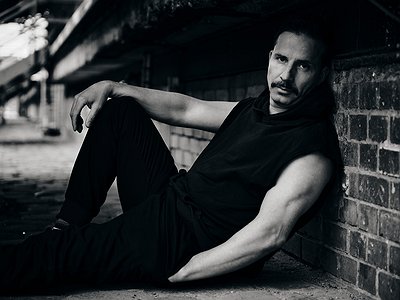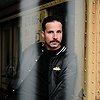Part 1
Name: Matthias Nowak aka No Mad Ronin aka ZentaSkai
Nationality: German
Occupation: Producer, label founder at Mask
Current release: Zentaskai's The Architecture of The Mind, an epic and deep journey across three 12inch records, is out October 6th 2023 via Mask.
Recommendations: Manuel Göttsching – E2-E4 and Rudolf Belling's sculpture – "Der Dreiklang."
[Read our Manuel Göttsching interview]
[Read our feature on Manuel Göttsching's E2-E4]
If you enjoyed this Zentaskai interview and would like to stay up to date with his music and projects, visit him on Instagram.
When I listen to music, I see shapes, objects and colours. What happens in your body when you're listening? Do you listen with your eyes open or closed?
Music fundamentally opens up spaces for me. When listening to music, depending on my mood, I want to be completely at home on my couch, in my studio, or flying through the expanses of space like a cosmonaut.
Sometimes, I travel back to my memories of distant places I've visited, such as the Amazon rainforest or the breathtaking valleys of Old Tibet in India, where mist rises, and sunlight reflects in a wonderful way. Some music manages to evoke the stored inner images. Music has always been connected to spatial experiences for me.
Sometimes I close my eyes; sometimes they are wide open. When I embark on a journey with music, which can also be a journey to myself to feel my own presence, my eyes are closed.
What were your very first steps in music like and how would you rate the gains made through experience - can one train/learn being an artist?
That's a very interesting question because I'm currently reading Rick Rubin's book: The Creative Act: A Way of Being. I share his opinion that there's an artist within each of us, and everything around us can serve as inspiration in the process of creating art if we can allow it.
I started as a singer in elementary school, although my parents initially forced me to sing in the school choir, but I didn't want to. At the end of 4th grade, I sang a solo in the gym in front of all the parents, teachers, and students. I was ten or eleven years old at the time.
Progress came from an inner urge to express myself through music over time. This urge manifested most strongly when I completed my high school with a diploma and started studying architecture. Especially during a seven-week road trip during that transition, traveling alone through California and Nevada music was often my only companion during that time.
According to scientific studies, we make our deepest and most incisive musical experiences between the ages of 13-16. What did music mean to you at that age and what’s changed since then?
Wow, that's a great question. At that age, there was nothing for me but skateboarding and snowboarding to good music. The music was hip-hop, breakdance, funk, skate-punk, and hardcore.
The feeling of skating or gliding through deep powder snow in the high mountains to the emotions that the music stirred in me was the greatest thing for me. It was a lifestyle that manifested in everything – clothes, parties, skating, snowboarding, and music.
Music is still a lifestyle for me, but it has changed over the years. Today, it's different music, and I also produce it myself. At 17, I started cutting and creating my own beats with two turntables and a Vestax battle mixer. I started producing hip-hop on a laptop using Samplitude software when I was 19. This was around the time when the first MP3 players became available, probably in 1998 or 1999. It was a revolution.
I was a turntablist for many years and participated in DJ battles or played with live loops and scratches in a jazz band during my studies. It wasn't until everything was stolen from my apartment due to a break-in that my relationship with music changed drastically. Records, turntables, laptop, stereo system – all gone. It took almost a year before I could even listen to music again. I avoided all places where music was played.
Only when a friend pushed me into the worst record store in town and waited outside until I came out with a record did I start to rediscover music on records. I think that took about 4 hours. I asked her why she did it, and she said she was tired of hearing my sad songs that I played on the guitar, which I had borrowed from a friend, as she lived below me in the apartment building. 
This rediscovery of music led me to buy two samplers in 2005: A Boss Dr. Sample 303 and an E-Mu SP1200. Years later, in 2009, during my last year at university, the person that broke-in my house sat next to me at one of the most historic places in the Weimar Republic. I didn't know whether to be grateful or to hate him when tears streamed down my face.
During my early years working as an architect after university, I produced a lot of music on my laptop in combination with samplers and synths, using software.
Music has always been a channel for me to express myself, unlocking and channeling creativity. Today, I play all my pieces live on my gear, getting closer to what's bursting out of me.
What, would you say, are the key ideas behind your approach to music and what motivates you to create?
The main ideas often come from something that surfaces and penetrates. Sometimes a simple impulse is enough for me to start producing.
It varies greatly what ultimately draws me into the studio, but most of the time, it's an inner urge. Sometimes, I take a specific thread or a prominent sound that's swirling around in my head.
As mentioned earlier, though, every sound I try to create must open up spaces or create a specific mood. Sometimes, I imagine a particular scene on the dance floor, atmospheric, mystical, and I hold onto that feeling until it manifests as a finished tune.
To quote a question by the great Bruce Duffie: When you come up with a musical idea, have you created the idea or have you discovered the idea?
I would say both. A finished piece of music is a work of art that I've created. In the process, we can always discover new sounds, even within ourselves.
I often discover new ways to create certain sounds or combine different sounds. I also frequently discover opportunities to combine elements from different genres, resulting in a new created sound.
Paul Simon said “the way that I listen to my own records is not for the chords or the lyrics - my first impression is of the overall sound.” What's your own take on that and how would you define your personal sound?
That's a wonderful statement by Paul. I agree with him 100% and would add the following:
Since the atmospheric component, the spatial aspect, has always played a significant role for me, I pay attention to whether a recording can open up the space I want to enter, how it takes me there, and how it brings me back.






